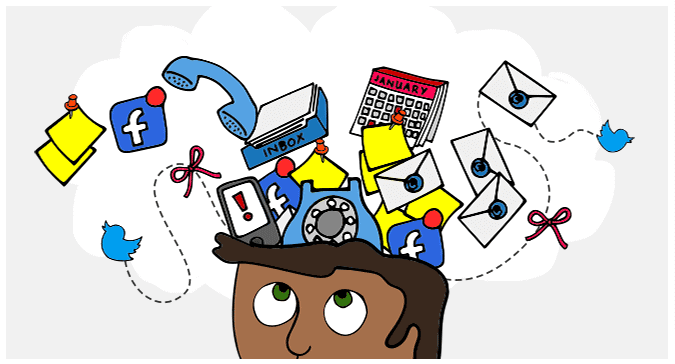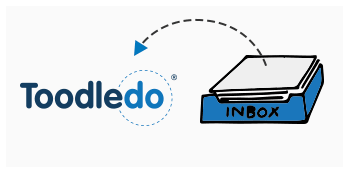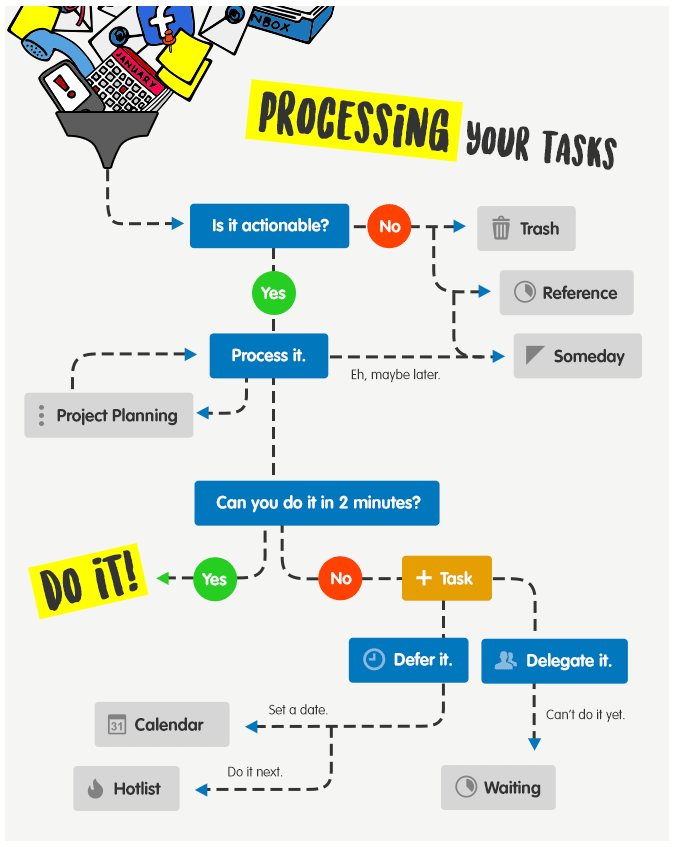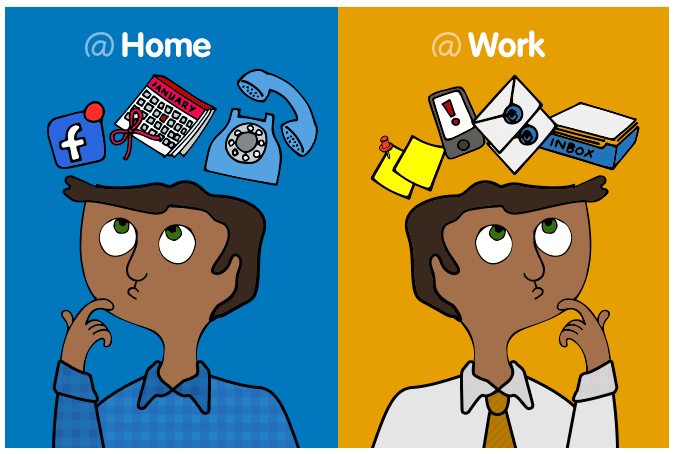Getting Things Done® (GTD®)
Using GTD and Toodledo to get organized and be productive!
Getting Things Done (GTD) is a method for organizing tasks so that you can focus your entire energy and creativity on completing those tasks in a stress free manner. This method was developed by David Allen in his book, Getting Things Done. The main principle of GTD is that recording your tasks in a reliable way - using a system that you trust - will free your mind from trying to remember and prioritize stuff. This recaptured mental energy can be put towards being more productive and efficient.
Collect all of your Tasks

The first step to GTD is collecting all of the information that is bouncing around in your head by getting it out of your mind. Without a system for recording ideas, your mind wastes a lot of energy by neurotically keeping those ideas fresh in your memory - you just can't stop thinking about them. Your thinking process will tend to go in circles, constantly thinking and worrying about the tasks that you must not forget.
If you can express your ideas in words and record them outside of your head, your mind will have permission to no longer waste energy trying to remember them.

Once all of your tasks are recorded in a trustworthy system that you can review whenever you want, you will no longer have to worry about forgetting to do anything.
Toodledo is the perfect collection bucket for this type of information. You can easily add information to your Toodledo list anytime you have an internet connection. For convenience, you can add tasks directly on our website or via our Browser Plugin. You can also access your list from any web capable mobile phone.

GTD also suggests that you have a physical in-basket to collect paper based materials. Whenever you do not have an internet connection, you should record your information on paper and toss it into your in-basket. Everything that ends up in your physical in-basket or in your Toodledo in-basket will be processed in the same way (described in the next step) and any valid tasks will be entered into Toodledo.
If you have not started the collection process yet, you should sit down and type in everything that is on your mind. It might be a good idea to create a folder in Toodledo called "To Be Processed" for all of these ideas. This will prepare you for the next step. You can quickly add tasks using our "Add Multiple" link from the task page. The average person starting the GTD method will probably have at least 50 tasks bouncing around in their brain that they need to get out.
Getting things done is easy to get started. Our fun GTD Brain Dump infographic will help you with the first collection step: a brain dump!
Processing your Tasks and Projects
The second step to utilizing GTD is to take all of the information that you have collected and process it into actionable pieces with clear next steps. This is where you will define projects and their associated tasks. According to author David Allen, the difference between a project and a task is that "you don't actually do a project; you can only do action steps related to it." A project is something that requires more than one action step to complete. You may need to spend some time thinking about a project before you can break it down into its constituent tasks. This is called "Project Planning". If you don't have time to do the project planning right now, you should create a task called "Do project planning for...". This, in itself, is the next step required for the project.

The difference between a project and a task is that "...you don't actually do a project; you can only do action steps related to it."
Here is an example of breaking down a project into action steps: "Buy a new car" may be something that you have written down, but this is not a task because it has no clear next steps. It would be better to create a project with an array of small actionable items that you can easily complete, such as: "Determine budget", "List features that I need", "Find a dealership", etc.

This GTD Processing and Organizing flow chart describes how to process and organize all the tasks and to-dos that you collected into an actionable plan. The blue squares explain how to do the "processing" step, and the gray squares describe how to do the "organizing" step, which is explained later. This flowchart has been modified from the original David Allen Workflow Diagram which can be found in the Getting Things Done book or from www.davidco.com.
In the processing step, the first thing to decide is if the item is actionable. In other words, is it possible to do it? If the answer is "no", then you need to decide if the item is reference material, junk, or something that may become actionable in the future. These categories are discussed more in the "Organization" step below. If the answer is "yes", then you can proceed to the "Process it" step.
In the "Process it" step, there are three paths that you can take. Ask yourself, "could I do it right now without thinking about it?" If the answer is "yes", then follow the "task" path. If you don't want to do it now, but might want to someday in the future, you can follow the "maybe later" path. If you need to do some project planning to break this item down into actionable next steps, then you can move into the "Project Planning" step.
For each legitimate task that you encounter, you should determine if you can complete that task in under 2 minutes. Many tasks (such as replying to an email) can be completed in under 2 minutes. You should do these tasks right away because the time it takes to record and manage these types of tasks is longer than the time it takes to just do them. For longer tasks, you need to decide when you want to do them. If it needs to be done on or by a certain date or time, you can schedule it into your calendar. Tasks that have no specific time can be put into your task list to be completed at the next possible opportunity. You also have the option of delegating the task to someone else.
Organizing your To-Dos
After you have processed an item, you will need to organize it in one of seven ways (shown with gray squares in the flow chart).
Trash
There is no value to keeping information that is useless. Keeping trash only adds to the clutter in our lives. Throw away anything that is not actionable or has no reference value.
Reference
A lot of the stuff that you collect will go into the reference pile. This includes paid bills, URL bookmarks, old tax returns, important papers, emails, project notes, journals, textbooks, etc. Toodledo does not store reference material, so you will need to get a sturdy filing cabinet. A common suggestion from GTD experts is to store everything in alphabetized file folders in your filing cabinet. This makes it quick and easy to dig something up.
Someday
This is where you put items that you are not sure you ever want to do, but maybe someday you'll think about them again. For example, you may want to climb Mt Everest, but not anytime soon. In Toodledo, you can set the priority of a task to be "Negative (-1)". This will hide the task from being displayed on the day-to-day task list. You can always choose to reveal these tasks and see if there are any "someday" tasks that you want to promote to active development.
Project Planning
When you have an item that needs to be broken down into its constituent actionable steps, you are in the "Project Planning" stage. In Toodledo, you can create a folder for this project and start brainstorming a list of the steps that must be taken to complete the project.
Waiting
When you have delegated a task to someone else, it goes into your "waiting" pile. Action can not proceed until someone else finishes their part. The sharing section of Toodledo allows you to easily delegate tasks to other people and keep track of their progress with those tasks.
Calendar
Any task that must be completed by or on a certain date can be given a due-date and time. When the date is approaching, Toodledo will bring your attention to it by increasing its visibility in your task list. You can also view your tasks on Toodledo's built in calendar or by synchronizing your tasks with Google's calendar or any other iCal capable organizer.
Task List
This is where the vast majority of your tasks will go. This is the master list. Toodledo defaults to showing you the entire list so that you can easily see everything that you need to do. Certain high priority items and tasks that are due soon will show up on your "Hotlist" so you know to do them first. It is easy to add items to this list and to modify existing items by just clicking on the information that you want to change and typing in the modification.
Doing your Tasks!
Although the majority of this article was spend describing the previous steps, you will be spending most of your time in the "Doing" stage. In this step, you will use your task list to determine what you should be working on. You can sort this list by a number of different criteria (priority, tags, context, goals, time estimates, etc.) in order to determine which tasks to complete next. For those people who can't decide what to work on next, Toodledo has an "Auto Scheduler" which analyzes your tasks and automatically picks the ones that will be the most effective use of your time.

Because you have already taken the time to ensure that each task on your list is actionable, you will not have to think about how to do it. Just do it.
After using this system for a few weeks, you should find that you are much more productive and that your mind is less cluttered and more stress free. That is the goal of "Getting Things Done".
Use Contexts to Stay Focused

Another important concept with GTD is the idea of "Contexts". A context is a particular location or time of day that relates to which tasks can be completed. For example, it is not productive to be reminded about house chores when you are at work, and it is not helpful to be reminded about phone calls that you need to make when you are not near a phone.
Some common contexts include home, work, phone calls, errands, school, computer, and the gym. With Toodledo, you can easily assign contexts to your tasks and then filter your list so that the only tasks that are displayed are the ones that are relevant to your current context.
GTD® and Getting Things Done® are registered trademarks of the David Allen Company. Toodledo is not affiliated with or endorsed by the David Allen Company.

